Innovative approaches to subsoil liming and management
Innovative approaches to subsoil liming and management
Author: Dr Guangdi Li (NSW Department of Primary Industries) | Date: 25 Feb 2020
Take home messages
- Lime is the most effective ameliorant to increase soil pH
- Organic materials are not as effective as lime in changing pH, but reduced exchangeable Al% significantly
- Applying lime with organic materials could facilitate downward movement of alkalinity
- However, over a longer term applying large amounts of organic materials could acidify soil due to nitrification.
Introduction
Subsoil acidity is a major constraint to ongoing productivity in the high rainfall zone (500–800 mm) of south-eastern Australia (Scott et al., 2000). Approximately 50% of Australia’s agriculture zone (~50 M ha) has a surface soil pH < 5.5 in calcium chloride (pH, hereafter) and half of this area also has subsoil acidity (SoE, 2011). In southern NSW, there are 13.5 M ha of agricultural soils exhibiting a subsurface soil acidity problem (Dolling et al., 2001). The agricultural production loss from soil acidity is estimated as $387 million in NSW (SoE, 2011).
The surface application of lime is a widely accepted practice to combat soil acidification at the surface (Scott et al., 2000; Ryan, 2018). However, lime moves very slowly down the soil profile so subsoil acidity will only be ameliorated after decades of regular lime application at appropriate rates to the soil surface (Li et al., 2019). Research from a long-term field experiment, known as MASTER, showed that pH increased at 0.04 pH units per year at 10-20 cm by maintaining pH above 5.5 at 0-10 cm with adequate lime application (Li et al., 2019). However, the current commercial recommended rate of 2.5 t/ha every 6-10 years is not enough to stop further soil acidification, as most of the alkalinity added is consumed in the topsoil with very little remaining to counteract subsoil acidification. Results from two soil surveys conducted in 2006 and in 2015-2017 in southern NSW showed that soil acidity is continuing to move further down the soil profile even where lime application is applied regularly over the 10 year period (Burns and Norton, 2018). We are acidifying our soils under contemporary minimum tillage farming systems.
The challenge is how to stop further soil acidification and speed up amelioration of subsoil acidity. The research questions are:
- Does deep ripping speed up amelioration of subsoil acidity? What is the rate of amelioration under deep ripping? Farmers need this information to make decisions on their capital investment (e.g. lime) and to estimate the economic return from the further investment for the cost of the deep ripping
- What is the role of organic materials in the amelioration of soil acidity? What types of organic materials are effective and what rates are required to achieve fast movement of alkalinity down the soil profile? Farmers need to be informed to strategically implement soil organic amendments to maximise profits in a longer term
- Is deep tillage a viable option to fix subsoil acidity? Farmers need to know the benefit of a “quick” fix of mixing soil with soil amendments by vigorous tillage compared with the perceived detrimental damage to soil structure and the environment in the short, medium and long term.
Methodology
A national coordinated project “Innovative approaches to managing subsoil acidity in the southern grain region” funded by GRDC (DAN00206) is testing whether aggressive application methods such as deep placement of lime and/or organic materials will achieve rapid changes to pH at depth.
A series of lab incubation studies and soil column experiments have been conducted under controlled conditions to
- Compare the effectiveness of a range of inorganic and organic amendments, and their combinations, to ameliorate soil acidity; and
- Optimise the application rates and application depth in soil profiles to identify the most effective soil amendments.
Four small plot field experiments and eight large-scale on-farm field experiments have been set up across southern NSW to north west Victoria to test optimum rates of the most effective soil amendments at various soil depths to validate their effectiveness under field conditions.
The inorganic amendments tested include lime, dolomite, magnesium silicate (MgSi), calcium nitrate, reactive phosphate rock (RPR), gypsum etc. The organic amendments tested include plant residues/materials (such as lucerne hay, pea hay, cereal crop straw, garden composts), animal wastes (such as poultry litters, dairy compost, sheep manure) as well as biochar, biosolids and k-humates.
Key results
Magnesium silicate
Magnesium silicate (MgSi) is a novel product that has potential as a soil ameliorant to elevate soil pH. The neutralising value of pure MgSi is estimated as 1.4 times higher than that of limestone.
A blended product of MgSi (70% Doonba dunite and 30% F70 superfine lime) with neutralising value about 100% was used at the Holbrook site from 2015-2017. Results showed that both deep liming and deep MgSi treatments increased soil pH significantly at the 20–30 cm depth (P<0.001) where soil amendments were applied compared with the no amendment treatment, three years after treatments were implemented (Figure 1). However, there was no significant difference in soil pH between deep liming and deep MgSi treatments at either 10–20 cm or 20–30 cm.
MgSi reduced exchangeable Al% (Al as percentage of effective cation exchange capacity) significantly at 10–20 cm (P<0.01) and 20–30 cm (P<0.05, Figure 2). The exchangeable Al% tended to be lower in the deep MgSi treatment than that in the deep liming treatment, but no significant difference was detected. Further research is required to explore whether MgSi is more efficient in decreasing Al toxicity than lime as claimed by Castro and Crusciol (2013).
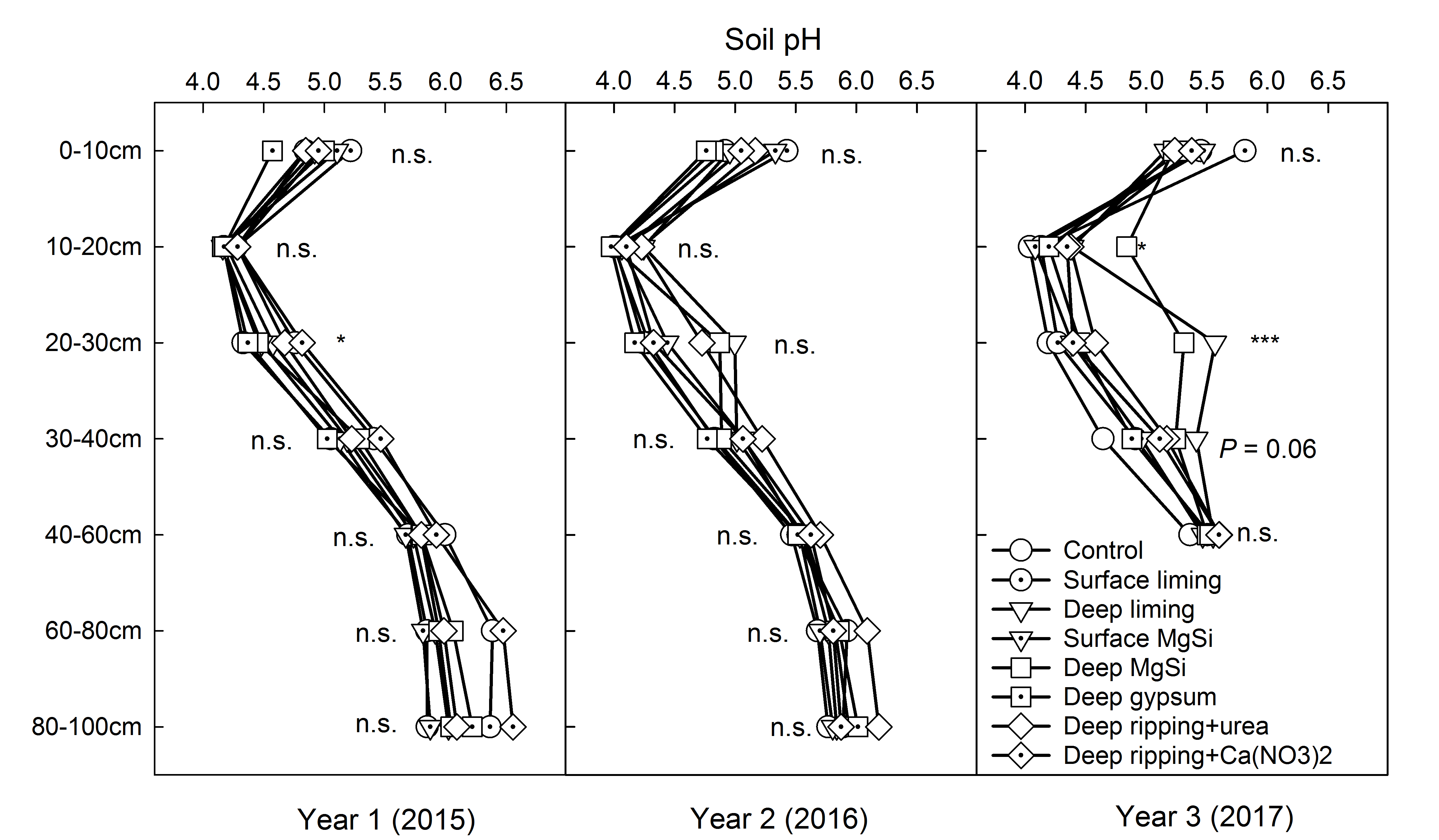 Figure 1. Soil pH in CaCl2 under different soil amendment treatments in autumn in years 1-3 at the Holbrook site.
Figure 1. Soil pH in CaCl2 under different soil amendment treatments in autumn in years 1-3 at the Holbrook site.
 Figure 2. Soil exchangeable Al% under different soil amendment treatments in autumn in years 1-3 at the Holbrook site.
Figure 2. Soil exchangeable Al% under different soil amendment treatments in autumn in years 1-3 at the Holbrook site.
Calcium nitrate
Calcium nitrate supplies plants with nitrogen in the form of nitrate, which would promote great anion uptake, leading to the release of OH- ions into the rhizosphere and thus increase of rhizosphere pH. There is potential for effect of root-induced alkalization in the rhizosphere to expand to ameliorate acidity in the bulk soil beyond the rhizosphere (Conyers et al.,2011; Tang et al., 2013).
Results from a pot experiment conducted by the La Trobe University researchers involved in this project showed that calcium nitrate not only increased rhizosphere pH, but it also increased bulk soil pH by 0.25 units in the Rutherglen and Bethungra soils, compared with those treated with urea over a short period (28 days)(Figure 3). Calcium nitrate addition also increased shoot biomass by 20% compared with urea in Rutherglen and Bethungra soils, but there were no treatment differences in shoot biomass in Frankston, Holbrook and Welshpool soils (data not shown). Results from a field experiment conducted at Holbrook showed that there was no significant difference in either pH or exchangeable Al between sources of N (urea vs calcium nitrate) over 3 years (Figure 1 and Figure 2). Thus, there is limited benefit to change of soil pH in the bulk soil over a long-term.
![Figure 3. Bulk soil pH for soils treated with urea, calcium nitrate [Ca(NO3)2] and slow release KNO3. Bars indicate standard errors of the mean (n=3). Black solid lines indicate initial soil pH This coloured column graph shows bulk soil pH for soils treated with urea, calcium nitrate [Ca(NO3)2] and slow release KNO3. Bars indicate standard errors of the mean (n=3). Black solid lines indicate initial soil pH](https://grdc.com.au/__data/assets/image/0029/390728/Paper-Li-Guangdi-Dubbo-Figure-3.png) Figure 3. Bulk soil pH for soils treated with urea, calcium nitrate [Ca(NO3)2] and slow release KNO3. Bars indicate standard errors of the mean (n=3). Black solid lines indicate initial soil pH
Figure 3. Bulk soil pH for soils treated with urea, calcium nitrate [Ca(NO3)2] and slow release KNO3. Bars indicate standard errors of the mean (n=3). Black solid lines indicate initial soil pH
Reactive phosphate rock
Reactive phosphate rock (RPR) contains slow release P with reasonable high alkalinity that could be used as a P source as well as a soil ameliorant for soil acidity. At the Rutherglen site, RPR at low (4t/ha) and high rates (8t/ha) increased canola grain yield by 0.5 t/ha compared with the limed control in year 1 (Figure 4), which was similar to the treatment with high rate of lucerne hay pellets (15t/ha). There were no yield responses with any other soil amendments (Figure 4).
Deep placement of organic materials may induce manganese toxicity due to enhanced oxygen consumption by microorganisms and poor aeration at depth. Positive results of RPR and lucerne hay pellets on yield may be due to improved nutrition and pH increase, indicating that interactions of these factors need to be investigated for growers to realise efficiency gains of amendment additions at depth.
In the second growing season, treatment effects were observed visually in the first 4 weeks of growth. Plants in the untreated control and surface liming treatments were small and spindly, whilst plants in deep amended treatments appeared healthier. However, due to harsh conditions during the 2018 growing season, the early visual symptoms did not carry through, resulting in non-significant differences between treatments at harvest. Despite this poor agronomic result in 2018, the results from soil sampling indicated that, in general, liming agents applied at the start of the 2017 season were maintaining positive effects on soil pH and exchangeable aluminium concentrations, which should improve plant growth under better seasonal conditions in future years.
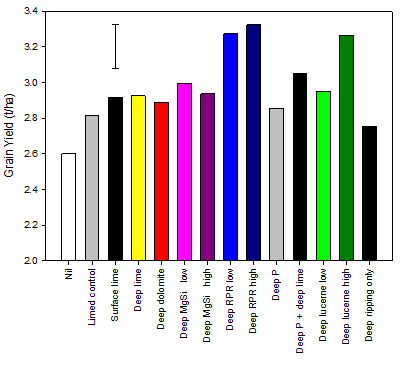 Figure 4. Harvest yield of canola (t/ha) for amendment treatments at Rutherglen site. Data are treatment means of 3 replicates. Bar indicates l.s.d. (P=0.05).
Figure 4. Harvest yield of canola (t/ha) for amendment treatments at Rutherglen site. Data are treatment means of 3 replicates. Bar indicates l.s.d. (P=0.05).
Organic materials
Organic materials can have a liming effect and thus may also be used as soil ameliorants to manage acid soils. However, the magnitude of any pH rise varies between amendments is dependent on their ash alkalinity and the concentration of excess base cations, which is reflective of the concentration of stored organic acid anions (Tang and Yu, 1999).
Lucerne hay pellets were used as a soil amendment at a rate of 15 t/ha throughout all field experiments. At the Cootamundra site, there was no difference in soil pH between treatments at any depth in year 1 prior to treatments being imposed. In autumn 2017, one year after treatments were applied, surface liming increased pH to 5.9 at 0-10 cm. The deep limed treatment with and without lucerne pellets significantly increased soil pH at 10-20 cm and 20-30 cm as expected. A similar trend was observed in 2018 (Figure 5).
The deep liming treatments, either with or without lucerne hay pellets, reduced exchangeable Al to less than 2% in 2017 and 3% in 2018 at 10-30 cm (Figure 6). Although lucerne hay pellets did not increase soil pH as much as expected, it did reduce exchangeable Al% significantly at 10–20 cm and 20–30 cm (Figure 3) compared with the no amendment treatment. This is likely to be the result of the soluble organic molecules from lucerne hay pellets combining with active Al3+ to form insoluble hydroxy-Al compounds (Haynes and Mokolobate, 2001), which would reduce Al toxicity to plant growth. The exchangeable Al remained high in the 10-30 cm depths under ripping only and surface lime treatments. The nil amendment treatment had the highest exchangeable Al at all three depths at 0-30cm.
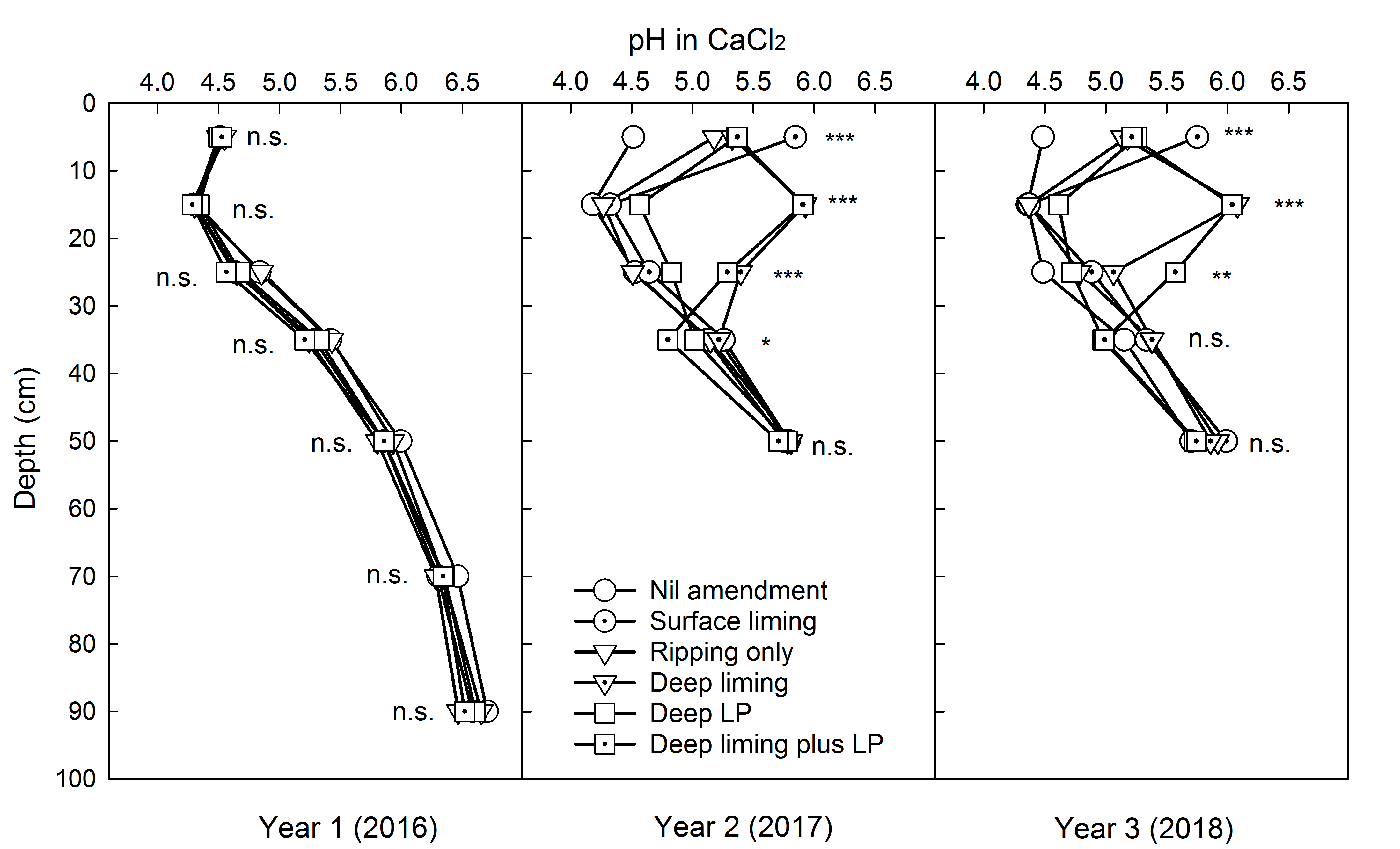 Figure 5. Soil pH in CaCl2 under different soil amendment treatments in autumn in years 1–3 at the Cootamundra site. n.s., not significant.
Figure 5. Soil pH in CaCl2 under different soil amendment treatments in autumn in years 1–3 at the Cootamundra site. n.s., not significant.
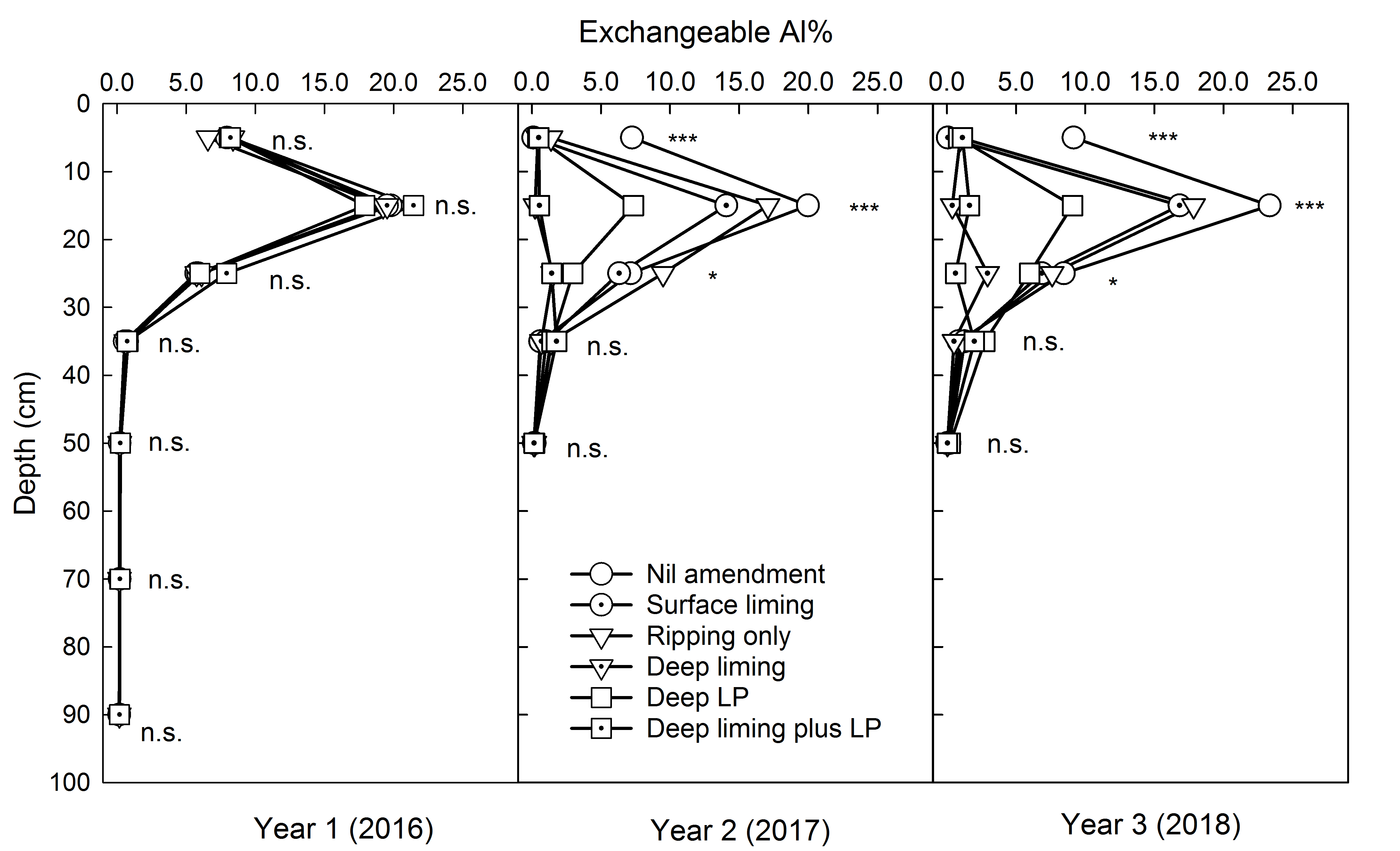 Figure 6. Soil exchangeable Al% under different soil amendment treatments in autumn in years 1–3 at the Cootamundra site. n.s., not significant.
Figure 6. Soil exchangeable Al% under different soil amendment treatments in autumn in years 1–3 at the Cootamundra site. n.s., not significant.
A range of organic materials with and without lime were tested in the field at the Holbrook site. At anthesis in year 1, the lucerne hay pellet treatment had the highest dry matter (DM) (9.6 t/ha), whereas the biochar with lime and wheat straw treatment had the lowest (5.2 t/ha) (Figure 7). Both poultry litter treatments had more than 8 t/ha of DM. At harvest, grain yield followed a similar trend to anthesis DM. The lucerne hay pellet treatment had the highest grain yield, close to 2 t/ha, followed by the poultry litter with lime treatment, whereas the lime treatment had similar grain yield to the control treatment (Figure 7). At seedling stage through to anthesis, the nitrogen content in plant tissues were higher under lucerne pellets and poultry litter treatments due to their high nitrogen content in the products. It is concluded that in the first year after treatments were implemented, crops responded to increased nutrient levels, particularly nitrogen, rather than to the amelioration of soil acidity.
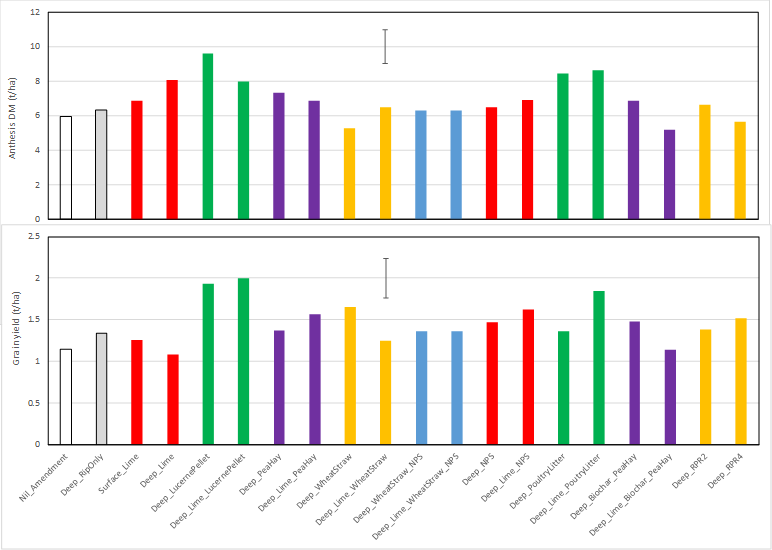 Figure 7. Crop dry matter (DM) at anthesis and grain yield at harvest under different treatments at the Holbrook site. The paired treatments with same colour are with and without deep liming except for the first 4 treatments on the left.
Figure 7. Crop dry matter (DM) at anthesis and grain yield at harvest under different treatments at the Holbrook site. The paired treatments with same colour are with and without deep liming except for the first 4 treatments on the left.
Lime + organic materials
The mineralization of organic materials is an alkaline process that increases soil pH, but the nitrification is an acid process that decreases soil pH (Helyar, 1976). Butterly et al. (2013) showed that plant residues can produce alkalinity below the layer applied. This is due to the leaching of organic compounds and organic acids, with any subsequent effect on pH being a function of ammonification, nitrification, and release of alkalinity by decarboxylation further down the profile.
The addition of lime with plant residues can generate alkalinity below the amended layer, create favourable pH gradients and may facilitate the downward movement of alkalinity from lime as demonstrated in a leaching experiment (Figure 8). Lucerne residues showed the greatest short-term increase in pH one month after incubation, but re-acidified soil after three months of incubation (Figure 8).
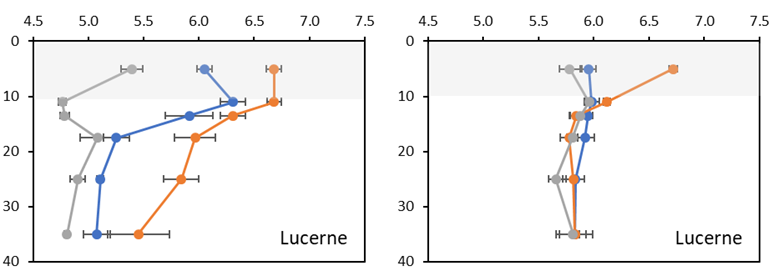 Figure 8. Soil pH profile in soil columns 1 month (left) and 3 months (right) after amendment (0-10 cm, shaded grey) with lucerne residues (blue line), lucerne + lime (orange line) and control (grey lines) (Clayton Butterly, La Trobe University, unpublished data)
Figure 8. Soil pH profile in soil columns 1 month (left) and 3 months (right) after amendment (0-10 cm, shaded grey) with lucerne residues (blue line), lucerne + lime (orange line) and control (grey lines) (Clayton Butterly, La Trobe University, unpublished data)
In field conditions, however, the addition of large amount of organic materials could acidify soil further over the longer term. Results from an intensive soil grid sampling at the long-term site at Cootamundra showed that soil pH beyond the ripping depth was lower under lucerne hay pellet treatments, with and without lime, compared with that under surface liming and deep liming treatments, four years after treatments were implemented (Figure 9).
 Figure 9. The spatial distribution of soil pH in CaCl2 in soil profile with (a) surface liming, (b) deep liming, (c) deep organic amendment, and (d) deep liming plus organic amendment Four years after treatments were implemented at the Cootamundra site in 2019
Figure 9. The spatial distribution of soil pH in CaCl2 in soil profile with (a) surface liming, (b) deep liming, (c) deep organic amendment, and (d) deep liming plus organic amendment Four years after treatments were implemented at the Cootamundra site in 2019
Summary
Subsoil acidity is difficult to manage. It will take decades for the current lime programs that apply lime the surface 0-10 cm layer regularly with appropriate rates aiming to ameliorate subsoil acidity. Deep placement of lime could speed up the amelioration process compared with surface liming. Given the nature of the ripping operation (Poileet al., 2012), the soil disturbance (and so the volume of soil treated) is restricted into a narrow slot. This is usually just 5-8 cm wide depending on the shape of the tyne used. This leaves large volumes of untreated soil. In addition, the vertical movement of lime is very slow and the lateral movement of lime is minimal (almost negligible). Therefore, it is unlikely that the constraint of subsoil acidity could be overcome in a short time frame. Further work is warranted to study whether a full tillage at depth is a viable option to amend the subsoil acidity problem. Growers want to know the economic benefit of the “quick” fix of mixing soil and soil amendment by vigorous tillage. They also want clarification on the perceived detrimental effects on soil structure and on the environment in the short, medium and long term.
A range of inorganic and organic soil amendments have been tested in a number of lab incubation studies and soil column experiments in glasshouse. Promising novel materials have been implemented in a number of field experiments and monitored over 2-3 growing seasons. The key findings are summarised below:
- Lime is the most effective ameliorant to increase soil pH
- MgSi is potentially more efficient than lime in decreasing Al toxicity
- Calcium nitrate can increase pH of the rhizosphere, but the effect on bulk soil pH is limited
- Reactive phosphate rock has a positive effect on crop yield, probably due to improved nutrition. Its role in increasing pH needs further investigation.
- Organic materials are not as effective as lime in increasing pH, but reduce exchangeable Al% significantly
- The mineralisation of organic matter increases soil pH in a short time frame
- However the nitrification would re-acidify soil and decrease soil pH in the medium to long term.
- The combination of lime with organic materials could facilitate downward movement of alkalinity from the lime in the short term.
- However, applying large amounts of organic materials could acidify soil due to nitrification over a longer term.
Acknowledgements
The research undertaken as part of this project is made possible by the significant contributions of growers through both trial cooperation and the support of the GRDC, the author would like to thank them for their continued support.
References
Burns HM and Norton MR (2018) Subsurface acidity threatens central and southern NSW cropping areas. In 'National Soils Conference 2018'. Canberra. (Soil Science Australia).
Butterly C, Baldock J, Tang C (2013) The contribution of crop residues to changes in soil pH under field conditions. Plant and Soil 366, 185-198.
Castro GSA and Crusciol CAC (2013) Effects of superficial liming and silicate application on soil fertility and crop yield under rotation. Geoderma 195-196, 234-242.
Conyers MK, Tang CX, Poile GJ, Liu D, Chen DL, Nuruzzaman Z (2011) A combination of biological activity and the nitrate form of nitrogen can be used to ameliorate subsurface soil acidity under dryland wheat farming. Plant and Soil 348, 155-166.
Dolling PJ, Moody P, Noble A, Helyar KR, Hughes B, Reuter D, Sparrow L (2001) 'Soil acidity and acidification.' (National Land and Water Resources Audit: Commonwealth of Australia).
Haynes RJ and Mokolobate MS (2001) Amelioration of Al toxicity and P deficiency in acid soils by additions of organic residues: a critical review of the phenomenon and the mechanisms involved. Nutrient Cycling in Agroecosystems 59, 47-63.
Helyar KR (1976) Nitrogen cycling and soil acidification. Journal of the Australian Institute of Agricultural Science 42, 217-221.
Li GD, Conyers MK, Helyar KR, Lisle CJ, Poile GJ, Cullis BR (2019) Long-term surface application of lime ameliorates subsurface soil acidity in the mixed farming zone of south-eastern Australia. Geoderma 338, 236-246.
Poile G, Oates A, Moroni S, Lowrie R, Conyers M, Swan T, Peoples M, Angus J, Kirkegaard J, Condon K, Durham K, Breust P, Armstrong R, Nuttall J (2012) Canola and subsoil constraints - Technical Bulletin. (Eds H Burns and T Nugent) p. 12.
Ryan P (2018) Assessing the role of genetics for improving the potential yield of Australia’s major grain crops on acid soils. Crop & Pasture Science 69, 242-264.
Scott BJ, Ridley AM, Conyers MK (2000) Management of soil acidity in long-term pastures of south-eastern Australia: a review. Australian Journal of Experimental Agriculture 40, 1173-1198.
SoE (2011) 2.2.5 Soil acidification. In 'Australia state of the environment 2011' pp. 287-293. (State of the Environment 2011 Committee: Canberra).
Tang C and Yu Q (1999) Impact of chemical composition of legume residues and initial soil pH on pH change of a soil after residue incorporation. Plant and Soil 215, 29-38.
Tang C, Weligama C, Sale P (2013) Subsurface soil acidification in farming systems: its possible causes and management options. In 'Molecular Environmental Soil Science' pp. 389-412. (Springer).
Contact details
Dr Guangdi Li
NSW Department of Primary Industries
Pine Gully Road, Wagga Wagga, NSW 2650
Ph: 02 6938 1930
Email: guangdi.li@dpi.nsw.gov.au
GRDC Project Code: DAN00206,
